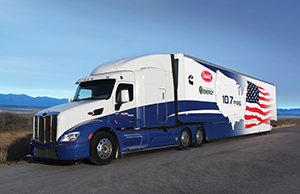
Heavy trucks, including those used in construction, are set to get a second round of fuel-economy restrictions that will extend into the next decade.
President Obama on Feb. 18 kicked off the second phase of federal fuel-economy standards for medium and heavy-duty trucks by calling on the Environmental Protection Agency and Dept. of Transportation. to publish a proposed rulemaking by March 2015 and issue a final rule by March 2016.
Current federal fuel-economy standards, which aim to reduce carbon-dioxide emissions, call for large trucks to cut fuel use by as much as 20% through 2018. The broad vehicle category, which was previously unregulated for fuel economy, is estimated to produce 23% of all transportation-related greenhouse gas emissions in the U.S., according to the White House.
The next phase calls for an even-tighter standard "so we can keep driving down oil imports and what we pay at the pump," said President Obama in a Jan. 28 State of the Union speech.
Roughly 1.5 million heavy trucks are produced every year, while light-duty vehicles, which are produced in higher volumes, are required to meet an average fuel economy of 54.5 miles per gallon by 2025. These regulations have forced manufacturers to develop higher-performing engines, explore lighter materials and make other changes to reduce fuel consumption.
Setting fuel efficiency standards for heavy-duty trucks is complicated due to their wide range of applications over the road. Under today's standard, long-haul trucks are required to cut fuel consumption by 20%, or 4 gallons per 100 miles. Heavy-duty pickups, vans and vocational trucks must shed 10% to 15% of their fuel use, or roughly 1 gallon per 100 miles.
As with the first standard, industry groups generally welcome better fuel economy, though some advise caution in the plan's second phase. Bill Graves, president and CEO of the American Trucking Associations, says that the trade group hopes regulators will "set forth a path that is both based on the best science and research available and economically achievable."



Post a comment to this article
Report Abusive Comment